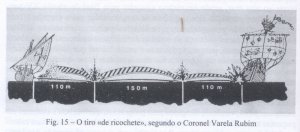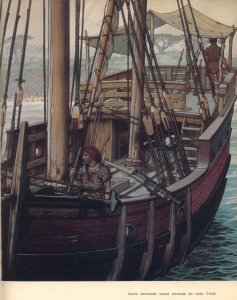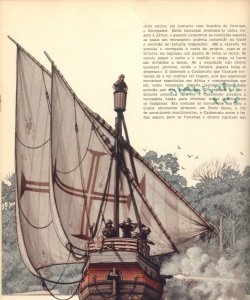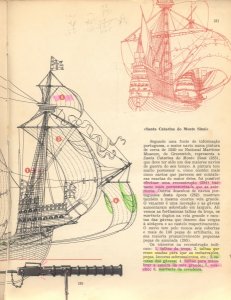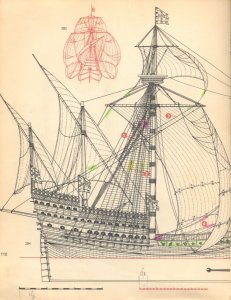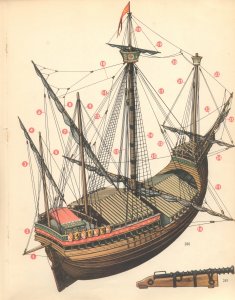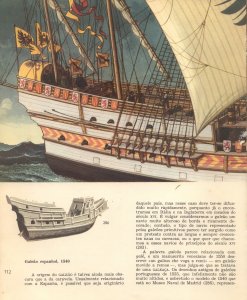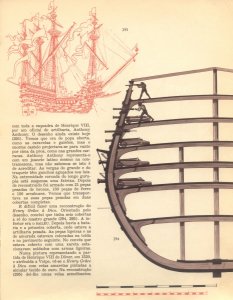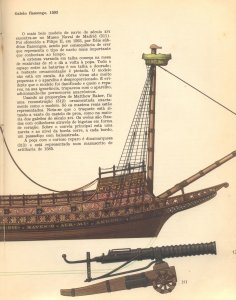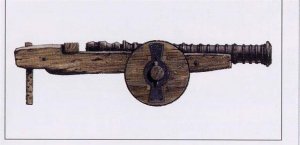Galleon San Salvador 1:33
- Thread starter PaperAir
- Start date
You are using an out of date browser. It may not display this or other websites correctly.
You should upgrade or use an alternative browser.
You should upgrade or use an alternative browser.
carlos filipe
carlos filipe
I got curious on the guns of the period of this galleon, after you started building it. The Portuguese and Spanish galleons must have been quite similar as it might have been the weapons onboard. I have recently read a book about an artillery fortress (Torre de S. Sebastião de caparica) on the side of Tagus where I live and about the king that ordered its construction, D. João the 2nd in 1481.
There are writen records of the king ordering the purchase of "heavy built" (my own expression) ships in France, suitable to test artillery onboard. And there are also writen documents stating fire tests (I'm not sure of the right term for direct fire in oposition to arch fire like a bombard or a modern mortar), on the Coast of Setúbal. Fire tests to study how to install guns onboard ships, calibers, range and all matters concerning firing at sea level (literally).
In this Museu Militar where I took the shots there are a lot of canons, most of them quite heavy. I think I have to pay a visit to Marine Museum to check how it looked the gun carriage of this period.
There are writen records of the king ordering the purchase of "heavy built" (my own expression) ships in France, suitable to test artillery onboard. And there are also writen documents stating fire tests (I'm not sure of the right term for direct fire in oposition to arch fire like a bombard or a modern mortar), on the Coast of Setúbal. Fire tests to study how to install guns onboard ships, calibers, range and all matters concerning firing at sea level (literally).
In this Museu Militar where I took the shots there are a lot of canons, most of them quite heavy. I think I have to pay a visit to Marine Museum to check how it looked the gun carriage of this period.
thank you very much for all your information carlos.
It's fascinating stuff.
carlos filipe
carlos filipe
I scanned some books I have home.
I found an image depicting the firing tests in the period of D. João II off the coast of Setúbal. It seems that the Portuguese were devoloping a method of extending the range with ricochet, this made with field tests and mathematical calculations. The method is very ingenious, replicating the principle of throwing a pebble over the water at a determined angle.
The objective was a direct hit beloow the waterline, imediatly disabling the opponent.
I found an image depicting the firing tests in the period of D. João II off the coast of Setúbal. It seems that the Portuguese were devoloping a method of extending the range with ricochet, this made with field tests and mathematical calculations. The method is very ingenious, replicating the principle of throwing a pebble over the water at a determined angle.
The objective was a direct hit beloow the waterline, imediatly disabling the opponent.
Attachments
carlos filipe
carlos filipe
I also found some ilustrations from Björn Landström a great Swedish ilustrator and Naval History investigator. The books are: "A Caminho da Índia" (on the path to India) and the other "The ship". He also have another book about Christovão Colombo. Books publised in the end of the 60s, begining of the 70s.
The following ilustrations are Portuguese caravels from mid XVth century. They help to see the evolution of colibrinas/coulivrines.
These small ships were ocean-going vessels. They would follow a coastal route down South, but to return, they were forced to drift to the middle of the ocean to find northbound winds and currents. Life onboard must have been miserable.
I have many doubts about the author's rendering of the hull colours. These ship and until at least mid XVIIth century were coated with a concoction of fish oil that gave them a tar colour. Eventually some colourful decorations on the upper part of the hull.
The following ilustrations are Portuguese caravels from mid XVth century. They help to see the evolution of colibrinas/coulivrines.
These small ships were ocean-going vessels. They would follow a coastal route down South, but to return, they were forced to drift to the middle of the ocean to find northbound winds and currents. Life onboard must have been miserable.
I have many doubts about the author's rendering of the hull colours. These ship and until at least mid XVIIth century were coated with a concoction of fish oil that gave them a tar colour. Eventually some colourful decorations on the upper part of the hull.
Attachments
carlos filipe
carlos filipe
The next ilustrations depict the Santa Catarina do Monte Sinai, the biggest ship of its time (ca. 1520), stil a nau or kraak, not a galleon. I could only find the depiction of a colibrina, but with good detail.
Attachments
carlos filipe
carlos filipe
The Venitian carraca or kraak (a term used in Northen Europe) shows a ship wich ratio lenght/widness is similar to the naus. Interesting detail in htis ilustration is the gun mount. A carriage with no wheels just two transversal boards to stand the recoil. Also impossible to understand how the elevation was done.
Attachments
carlos filipe
carlos filipe
carlos filipe
carlos filipe
carlos filipe
carlos filipe
Finally a dutch galleon dating from 1593, a model offered to King Filipe IInd of Spain and still preserved in the Museo naval de Madrid.
What is for me more revealing is the system of elevation of the gun.The carriage consists of two wheels and a kind of skid. The elevation mechanism is above the carriage. On the one PaperAir shows from his research, the elevation is a pole that goes through the carriage and stands on the deck. Looks unstable to me and I wonder what would hapen to the deck having a stick scratching the deck's boards after a violent recoil.
What is for me more revealing is the system of elevation of the gun.The carriage consists of two wheels and a kind of skid. The elevation mechanism is above the carriage. On the one PaperAir shows from his research, the elevation is a pole that goes through the carriage and stands on the deck. Looks unstable to me and I wonder what would hapen to the deck having a stick scratching the deck's boards after a violent recoil.
Attachments
Z
Zathros
If you look at that picture closely, the pole has holes which go into the ring just below it where there is probably a pin inserted perpendicularly to lock in the elevation. The metal frame which supports the pin is fixed on the base of the gun and also on top of the elevation pivot point. The gun goes up and down, but that frame does not move. It also looks like this arrangement has the whole gun assembly mounted so that it pivots left to right, as well as up and down. As far as the French ship, they must have relied on the roll of the ship! 
carlos filipe
carlos filipe
My doubt is about this ilustration of a gun from a spanish galleon from 1530. The solution with the elevation pole holding on the deck seems to me too flimsy and wonder wht would do to the deck planking with the violent recoil.
My data dates at least 40 years, a lot of things have been discovered. I feel that it makes more sense the elevation to stand on the carriage rather than going though it and sit on the deck.
I'm raising this doubt as I would like to know a little more about it. Checked on the San Diego Museum but online couldn't find anything about this matter.
My data dates at least 40 years, a lot of things have been discovered. I feel that it makes more sense the elevation to stand on the carriage rather than going though it and sit on the deck.
I'm raising this doubt as I would like to know a little more about it. Checked on the San Diego Museum but online couldn't find anything about this matter.
Attachments
Z
Zathros
My doubt is about this ilustration of a gun from a spanish galleon from 1530. The solution with the elevation pole holding on the deck seems to me too flimsy and wonder wht would do to the deck planking with the violent recoil.
My data dates at least 40 years, a lot of things have been discovered. I feel that it makes more sense the elevation to stand on the carriage rather than going though it and sit on the deck.
I'm raising this doubt as I would like to know a little more about it. Checked on the San Diego Museum but online couldn't find anything about this matter.
With the cannon you showed, all you would have to do is evade their gunfire till their own gun tore their planks apart!
Z
Zathros
they are far from complete.I just looked at the Instructions .pdf, I would stick with those. They look good.
carlos filipe
carlos filipe
I looked at the instructions and the designers admit it is a simplified version. Ther I'm totally lost, cannot say a thing, except to try to interprete the Björn Landström ilustration of a galleon. He was very knowleageble. I keep on finding ilustration based on his work. The technology of riggiing the sails evolved amazingly in this period,
Z
Zathros
They are very basic but all the basic elements for positioning the sails are present. I think the problem is when you make a boat the small, you get into a problem of the gauge and weaves of the ropes. I made a 3 foot model of the Constitution and the gauge of the ropes was a real big deal. You can buy all this stuff but it cost a pretty penny ( and that doesn't include the weave of the rope to the scale of the rope, that's when it starts to coast a lot.). Also, how are you going to portray the ship? Not all lines were up when in use. That ship was said to have a boom that hung off of the rear like a yawl. I think it matters if it is under sail, or in port. Is she closed hauled, on a run or downwind haul. All these mean different ropes being used and other ropes stowed. Pick a position for the ship, then researching what ropes would be needed for that type of sailing would make for an easier choice. It's always a matter of how detailed you want to go. In this case, you put up all the ropes needed, start researching the gauge and weave of the rope. I think the boat made as is would be quite convincing and some more could always be added on with tweezers, and patience. 


